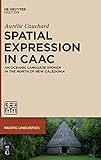Spatial Expression in Caac : An Oceanic Language Spoken in the North of New Caledonia / Aurélie Cauchard.
Material type: TextSeries: Pacific Linguistics [PL] ; 650Publisher: Berlin ; Boston : De Gruyter Mouton, [2018]Copyright date: ©2018Description: 1 online resource (XIV, 310 p.)Content type:
TextSeries: Pacific Linguistics [PL] ; 650Publisher: Berlin ; Boston : De Gruyter Mouton, [2018]Copyright date: ©2018Description: 1 online resource (XIV, 310 p.)Content type: - 9781501511547
- 9781501503351
- 9781501503498
- 499
- online - DeGruyter
- Issued also in print.
| Item type | Current library | Call number | URL | Status | Notes | Barcode | |
|---|---|---|---|---|---|---|---|
 eBook
eBook
|
Biblioteca "Angelicum" Pont. Univ. S.Tommaso d'Aquino Nuvola online | online - DeGruyter (Browse shelf(Opens below)) | Online access | Not for loan (Accesso limitato) | Accesso per gli utenti autorizzati / Access for authorized users | (dgr)9781501503498 |
Frontmatter -- Acknowledgements -- Table of contents -- Abbreviations -- I .The Caac language -- 1. Introduction -- 2. Sketch Grammar -- II. Linguistic resources for spatial reference in Caac -- 3. Overview of location, motion and orientation constructions -- 4. Spatial verbs -- 5. Nominal, prepositional and adverb phrases encoding spatial bearings -- 6.Directionals -- III .Analysis of space in Caac -- 7 .Theoretical framework -- 8. Vectorial analysis of spatial expressions in Caac -- 9. Conclusion -- 10.Bibliography -- Index
restricted access online access with authorization star
http://purl.org/coar/access_right/c_16ec
In this study, the author describes the linguistic expression of space in Caac, an endangered and under-documented Oceanic language spoken in New Caledonia, from both a descriptive and theoretical perspective. Part I provides a concise description of Caac grammar, presenting a first formal portrait of this language to the reader. Part II describes the formal and semantic features of the linguistic resources available in Caac to encode spatial relationships. Part III presents the theoretical framework based on and exploring further the vector analysis developed by Bohnemeyer (2012) and Bohnemeyer & O'Meara (2012). In particular, the author proposes an additional sub-category of vectors (Head-unspecified Vectors) which accounts for the uses of centrifugal forms in Caac. The resulting framework provides a systematic account of expressions of orientation as well as location and motion, and to combine the Frames of Reference typology (Pederson et al. 1998; Levinson, 1996, 2003; Bohnemeyer & Levinson, not dated) with an analysis of deictic expressions within a single framework. Special attention, moreover, is given to the use of Caac absolute and deictic directionals in spatial constructions involving Fictive Motion. The analysis of Caac data leads us to introduce an additional category of Fictive Motion beyond those previously recognised in the literature, labelled here "Anticipated Paths", which in turn shed new light on the nature of vectors and the relationship between location, motion and orientation.
Issued also in print.
Mode of access: Internet via World Wide Web.
In English.
Description based on online resource; title from PDF title page (publisher's Web site, viewed 25. Jun 2024)


